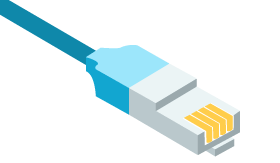Internet options in Japan for visitors or new residents (SIM cards, Broadband, Pocket Wi-Fi)

Many first-time visitors to Japan are surprised to find that free Wi-Fi is not as common as they might have expected. These days, tourist accommodation almost always offers free Wi-Fi for guests, but long-term housing does not generally come with an internet connection. Whether you are just traveling to Japan or moving here, these are your main options for access to the internet.
Internet on your Mobile Phone - Prepaid SIM cards
To avoid getting lost when you first arrive in Japan, it can be a good idea to purchase a prepaid SIM card for your mobile phone (cell phone) or tablet. Many different companies in Japan offer prepaid data-only SIM cards with a wide range of data plans available. Given the hassle involved with obtaining a full mobile phone plan and phone number, such data-only prepaid SIM cards are usually cheaper, simpler, and more convenient.

SIM card plans differ based on connection speeds, networks, and data transfer limits (via hotspots). Typical plans offer specified maximum data amounts (e.g 1-10 GB) over a set time period (e.g. 5 days, 7 days, 10 days…).
Where to buy a SIM card
For short-term visitors to Japan
No matter the airport, there will almost always be a counter selling prepaid data-only SIM cards in or near the Arrivals area. You can also find prepaid data-only SIM cards for sale in major electronics stores such as BIC CAMERA or Yodobashi.
Make sure that your smartphone has been unlocked and is able to use a prepaid SIM card. You should also check which type of SIM card your device requires (nano, micro or regular).
For long-term visitors to Japan or new residents
The three main mobile phone companies in Japan are Docomo, au and SoftBank, which all have their own networks. There are no major differences between them and they generally provide the most stable networks in the country.
There are also currently many alternative mobile phone SIM card providers operating in Japan that lease networks from the three main companies but tend to offer much more attractive rates. For this reason, we highly recommend purchasing your SIM card from one of these alternative SIM card providers and subscribing to their service instead of one of the big three.
Here are the most popular alternative SIM card providers offering cheaper rates.
Unlike Docomo, au, or SoftBank, most alternative SIM card providers do not have stores or service counters where you can inquire in person about their services (you generally need to apply online). One exception is Y!mobile, one of the most popular alternative SIM card providers, which does have stores in major Japanese cities. UQ Mobile and Rakuten Mobile also have physical stores.
Advantages
The biggest advantage of prepaid data-only SIM cards is that they are simple and quick to purchase and install. You will not even be asked to show ID when you buy one. Sometimes there will be a short registration process to complete, but this can be done right there on your mobile phone and the staff at the shop or counter will be happy to assist you.
If you are traveling in Japan for a few weeks, a SIM card should provide enough data to last you through your stay. You can also use FaceTime, Whatsapp, or Skype to make phone calls in order to avoid roaming charges.
Disadvantages
If you are a solo traveler and your mobile phone can be used as a hot-spot, a SIM card is usually enough. However, prepaid data-only SIM cards are not ideal for groups or for those who wish to use several devices. While a hotspot is generally sufficient for browsing the web on your computer, it might not be adequate for sharing data among several friends or family members (i.e. among several devices).
Another disadvantage is that most prepaid SIM cards have a limited amount of data before your connection speed slows down. If you enjoy watching videos on your phone (beware, Netflix addicts!), a prepaid data-only SIM card may not be the best option for you.
If you are moving to Japan or planning to stay for a while, a data-only SIM card might seem like a tempting option, but it will not provide you with a Japanese phone number, a necessity for many essential services in Japan (such as renting an apartment). You will need to sign up for a long-term SIM card with voice calls and data. Most alternative providers also offer options for those who will be in Japan long-term.
Finding Free Wi-Fi in Japan The best places to find free public Wi-Fi in Japan are coffee shops (especially large chains such as Starbucks or Tully’s), convenience stores (especially Family Mart and 7-Eleven), train stations and airports, museums, and some fast food restaurants (MacDonald’s always has Wi-Fi). The Shinkansen and some other train lines (and even bus lines) do have free Wi-Fi, but connections can be unreliable due to tunnels or other obstacles.
Summary: SIM cards
- Cheap, quick, and simple to purchase and install
- Convenient for solo travelers
- Limited usage period, limited amount of data
- Not enough data for groups, multiple devices, or streaming videos
Internet at Home: Broadband

If you are moving to Japan and will live in your own private home for a long period of time (over a year), you might want to get a high-speed broadband connection of your own.
Some internet service providers (ISPs) are more user-friendly for non-Japanese speakers and can provide you with a fixed-line internet connection. One such provider is Sakura Internet, which has excellent customer service in English. Sakura’s rates are slightly higher than major providers such as Hikari Kaisen, but Hikari Kaisen requires communication by telephone in Japanese.
The Japanese Ministry of Internal Affairs and Communications has decided to stop repairing old ADSL lines and fully shift to FTTH (fiber-optic cable). Applications for ADSL connection lines ceased in February 2018 and the service itself is set to disappear by 2023.
Fiber-optic cable is thus now the fastest and most popular choice for home internet connections in Japan.
Cabling and ISP in Japan - Separate ProvidersIn Japan, hardware (physical connection lines/cables) and ISPs are separate (unbundled), meaning that if you wish to have broadband installed at your home, you will have to apply to both a line provider and an ISP.
Getting your broadband internet set up
The setup procedure will vary depending on whether or not your building is already equipped with adequate FTTH connection lines/cables.
If your building or apartment is already physically connected, you will only have to proceed to the ISP application and then connect your Wi-Fi router to start using your connection.
If your building or apartment is not physically connected, you will need to make an appointment with your contracted line operator to come and install the line. You must be at home while the installation takes place (up to two hours).
Advantages
Fiber-optic cables offer the fastest connections in Japan, faster than many other countries in the world, with download speeds reaching 1Gbps (1 Gigabyte per second).

This option is very efficient for families or those using multiple devices. You can also combine your internet plan with a phone line (this costs more though, of course).
Disadvantages
Contracts are usually quite long (minimum 1 year, but generally 2 years) and canceling your contract before it ends carries a high penalty fee (usually ¥8000-¥10000).
In addition, while most major fiber optic internet providers in Japan have English websites, the actual level of customer service in English will vary depending on the company and the individual technician who visits your home.
Summary: home broadband
- Fastest internet connection possible
- Convenient for families using multiple devices
- Long-term contracts with penalty fees for early cancellation
- English support not always available
- Line installation process can be a hassle
- Available in large metropolitan areas but not everywhere else
Internet in your Pocket - Pocket Wi-Fi (a popular alternative)
If you will only be living in Japan for a few months and want to use the internet both on your phone and while at home, renting a portable Wi-Fi router might be the best option for you! This is a great way around the hassle of getting fiber-optic cables set up at your home and paying high cancellation penalty fees that accompany long broadband contracts.
Commonly known in Japan as Pocket Wi-Fi, these devices are actually small portable battery-powered Wi-Fi routers. They are a fairly cheap and simple option that tends to suit families or groups better than SIM cards, as several devices can log on to the same router. Data is usually unlimited.
Where to rent a Pocket Wi-Fi
As with prepaid SIM cards, Pocket Wi-Fi rental services are generally available at all major airports in Japan. To save you time, most companies offer the option of booking your router in advance and having it delivered either to the airport of your choice or directly to your accommodation.
Ninja Wi-FiNinja Wi-Fi is one of the most popular wifi rental services in Japan. Ninja offers the option to register your application online and pay before your arrival. Find out more here!
CDJAPAN Rental CDJapan Rental offers a range of Pocket Wi-Fi devices with flexible plans and reliable coverage. Their website allows you to book in advance and choose delivery to airports, hotels, or even your Airbnb. You can also return your router using a prepaid envelope from any Japanese mailbox.
Check out CDJapan Rental here
Advantages

Price and convenience are the two biggest advantages of pocket Wi-Fi. Rates are reasonable and pocket Wi-Fi is suitable for groups of travelers. Setup is extremely simple as all you need to do is turn on the device and enter the password into your phone, tablet or computer to connect to the Wi-Fi network.
Connection speeds are adequate and connection is available anywhere there is mobile phone service.
Finally, with most providers, you can easily return your router at the airport or via the mail before you leave.
Disadvantages
Slight disadvantages are that the router works on a battery (it usually lasts up to 10 hours) and that you have to carry it around with you anywhere you want to access the internet (however, it is not much larger or heavier than a mobile phone).
Summary: Pocket Wi-Fi
- Cheapest option for groups or those using multiple devices (phone, computer, tablet...)
- Access to the internet from anywhere: at home or when on the move
- Easy registration and connection
- Unlimited data (usually)
- Battery-powered (typically 8-10 hours battery life, rechargeable)
- Portable (must be carried with you if you want to use the internet)
